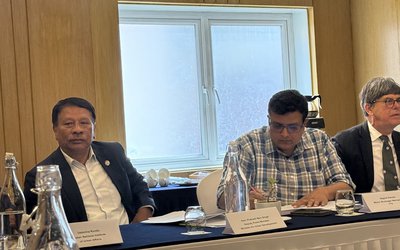
In Climate Vulnerable Forum (7 October 2020) and Climate Ambition Summit (12 December 2020), the Prime Minister K.P. Sharma Oli called to limit global warming to 1.5oC, and informed to submit enhanced Nationally Determined Contribution (NDC) by the end of 2020. In December Summit, Prime Minister also informed Nepal's aims to 'move towards a zero-carbon economy' and 'extend protected area from 23% to 30% by 2030'. Nepal's second NDC was uploaded on 8 December 2020 in UNFCCC website while statement of the Head of the Government on 12 December mentioned 'will submit enhanced NDC'.
The 2020 NDC contains ambitious targets for sector-based greenhouse gases (GHGs) emission reduction (https://www.spotlightnepal.com/2020/11/24/ambitious-draft-ndc-2020/). It reflects the strong commitments of the Head of the Government in reducing GHGs emissions, promoting climate-resilient adaptation plans in all local levels, and developing climate finance strategy and roadmap by 2021. On 16 December 2020 at the launch of the Human Development Report 2020, the Minister for Foreign Affairs Mr. Pradeep K. Gyawali, linking with the 5th anniversary of the Paris Agreement, informed, inter alia, Nepal's commitment on climate-resilient development, and zero-carbon economy.
Nepal's targets as contained in the NDC2 are mostly conditional upon international support. Unlike 2016 NDC, the 2020 NDC embraces the original concept of GHGs emissions reduction in spite of her 0.027 percent share on the global total GHGs emissions. There is a possibility to meet the targets on residential cooking and biogas energy through the effective implementation of Nepal's CDM (Clean Development Mechanism) projects on improved cookstoves and biogas, including Rural Energy Policy (2006) and Renewable Energy Subsidy Policy (2016). Increasing use of LPG for cooking purpose in rural areas and REDD+ initiatives may support to maintain 45 percent forests. In addition, targets related to the preparation of the strategies, action plans, guidelines or mechanisms will be met easily as Nepal is very active in formulating 'non-legally binding' policies. With this in perspective, the following section focuses on priorities of the national sectoral policies on climate change.
After the adoption of the Climate Change Policy in 2011, over a dozen sectoral policies have included provisions for addressing climate change impacts in Nepal. Prior to 2011 Policy, Industrial Policy (2010) mentioned to take special measures to promote green industries and make the established industries pollution free and 'zero to carbon emissions'.
Of 16 national policies reviewed, over 80 percent focus on adaption and mitigation of climate change impacts rather than GHGs emissions reduction. The National Climate Change Policy (2019) which repealed 2011 Policy also provisions for increasing carbon storage in forests, identification of GHGs emitting points in industry and transport sectors, implementation of standards for emission reductions, promotion on uses of electric vehicles & energy efficiency, and phasing out of highly polluting means of transportation. Similarly, zero emission concept has been introduced for tourist places. The Environment-friendly Vehicle and Transport Policy provisions for replacing fossil fuel-based vehicles to electric vehicles and reduce GHGs emissions and commits to operate electric vehicles at least 20 percent of the total vehicles by 2020. However, this target has not been met in 2020. The National Forest Policy intends to increase wood production to reduce carbon emissions, including a strategy to utilise an opportunity for payment from international mechanisms for carbon emissions reduction from forests. The Rangeland Policy has a provision for conducting research on rangeland's contribution in carbon sequestration.
The policies on wetland, irrigation and agriculture biodiversity have focussed to adopt appropriate adaptation options and implement mitigation measures to address climate change impacts. The policies on water-induced disaster management and land use provision for integrating climate change adaptation into medium-term and long-term plans, and land use plan to reduce climate change effects.
In 2019, the Government issued 5 national policies (health, forest, agro-forestry, poverty alleviation, and climate change) that provision to address and mitigate adverse effects or impacts of climate change, develop climate-resilient ecosystem, build capacity, and implement adaptation programmes.
The 2019 Climate Change Policy has objectives of enhancing capacity of climate vulnerable on adaptation, developing ecosystem resilience, promoting green economy, accessing international resources, and mainstreaming gender and social inclusion in mitigating and adapting to climate change impacts. This Policy gives a clear message on national priorities on adaptation and mitigation of impacts which aligns with the statements of the Heads of the State and/or Government at international fora.
In 2020, the Government has issued policies on water resources and foreign relations. The Water Resources Policy provisions to implement plans and programmes that are adaptive to the effects and impacts of climate change, including update of climate data, and adoption of adaptation technologies such as rain water collection, pond construction etc.
Policies with provisions on Climate Change
- Industrial Policy, 2010
- Rangeland Policy, 2012
- National Wetland Policy, 2012
- Irrigation Policy, 2013
- Environment-friendly Vehicle and Transport Policy, 2014
- Agri-Biodiversity Policy, 2014 (amendment)
- Water-induced Disaster Management Policy, 2015
- Land Use Policy, 2015
- Renewable Energy Subsidy Policy, 2016
- National Health Policy, 2019
- National Forest Policy, 2019
- National Agro-Forestry Policy, 2019
- Poverty Alleviation Policy, 2019
- National Climate Change Policy, 2019
- Water Resources Policy, 2020
- Foreign Policy, 2020
The Foreign Policy, released in December 2020, considers 'conservation of the planet' as one of the guiding principles, commits to align the sectoral policies with this Policy, and 'minimise climate change effect'. The Policy provides provisions for playing effective role on adaptation and GHGs emissions reduction to fight against climate change challenges and its adverse impacts. Strategies focus to playing an active and 'frontline' role on international processes, accessing necessary financial resources and technologies for adaptation and effects mitigation, and urging to implement 'polluters pay principle', 'common but differentiated responsibilities', and 'carbon trading'. This Policy also provisions for, inter alia, expansion of 'petroleum and gas pipelines', actively coordinate and collaborate to reduce climate change effects; and project 'carbon-neutral' Nepal at the international level. Except on 'carbon-neutral' Nepal, other policies and strategies focus only on mitigation of adverse impacts of, and build adaptive capacity, to climate change.
The above policies reflect national priorities on adaptation, and mitigation of climate change effects or impacts while Second NDC commits to reduce GHGs emissions. In a discussion forum on draft 'eNDC', one person urged to submit more ambitious NDC to inform international community on Nepal's strong commitment on GHGs emissions reduction, with clear reflection that there is no need to fulfil such commitments. With simple guess, this 'thought' dominated in finalising NDC2. It is simply a 'confidence without clarity'. Implementation of NDC2 started on 1 January 2021. It is most likely that a review on NDC implementation in 2025 and 2030 may conclude that both 'conditional and unconditional targets' have not been met as priorities of the national policies and commitments in NDC2 look like 'banks of the same river.'

Batu Uprety
Former Joint-Secretary and Chief of Climate Change Management Division, Ministry of Environment (then), and former Team Leader, National Adaptation Plan (NAP) formulation process. E-mail: upretybk@gmail.com
- Sagarmatha Sambad: Likely Bearing the Fruits
- Mar 27, 2025
- Decadal Experience In Preparing The NDC
- Mar 03, 2025
- Over Five Decades Of Concern On Air Pollution
- Jan 16, 2025
- Damaging The Functional EIA Track
- Dec 22, 2024
- Baku CoP29 Outcomes And Nepal's Initiatives
- Nov 26, 2024














